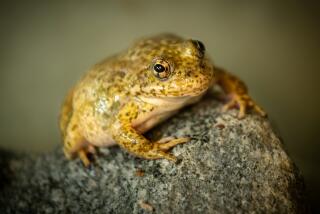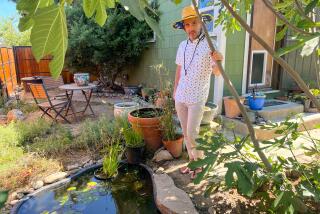No Need to Gild Lilies: Frogs Like Ponds, Warts and All : Landscaping: Easy to install and maintain, a simple back-yard pool makes a hospitable habitat for local amphibians.
Brreeet, rribbit, rribbit.
That’s the call of a male frog trying to entice a female out of hiding. It’s a sound not commonly heard in a typical suburban neighborhood, but one that can become common with the introduction of a pond.
It’s sort of like in the movie “Field of Dreams”: If you build a back-yard pond, the frogs will come.
The Pacific tree frog, Hyla regilla , is the most abundant frog in the West and certainly the one most likely to set up housekeeping in a back-yard pond. (No, tree frogs aren’t only found in trees.) And they have a much more delicate call than the exotic bullfrog that can be bought at most pet shops.
Why build a pond for frogs? For one, while frogs do not seem to be in decline in Orange County, their habitat is dwindling.
An international scientific conference on the frog was held in 1990 at UCI. There was speculation at the conference, hosted by the National Academy of Sciences, that frogs are disappearing at an alarming rate worldwide. Studies are underway to discover if the amphibians are in a crisis or just a natural population flux.
“There used to be lots of drainage ditches and natural ponds in Orange County,” said Tim Watkins, a graduate student in evolutionary biology at UCI. “With more and more land being developed, there are fewer places for frogs to live.”
Building a back-yard pond will not only help increase hospitable--albeit artificial--housing for frogs, it is also a way to bring a bit of the wilderness into otherwise tame neighborhoods not used to nighttime croaking.
Another back-yard benefit to a pond is that frogs eat bugs, specifically irritating bugs such as mosquitoes. (And speaking of the food chain, keep in mind that there is some danger to frogs from cats, especially feline hunters. Dogs are not as much a problem, although they are likely to bark at frogs.)
Unlike koi or other fish ponds, which are expensive and take a great deal of skill to build and maintain, building a garden or natural pond is a relatively inexpensive and uncomplicated process. All that’s needed for a frog-friendly pond is a shallow standing pool of water, a few rocks to hibernate under during winter and some aquatic grasses.
“It’s not that labor-intensive either,” said Mark Gneiding, owner of Aquatic Specialists in Santa Ana. “You can pick up one of those little plastic pond liners at Home Depot, (then) just lay it into the hole you dig.”
The most popular preformed ponds are made of polyethelene and come in a variety of shapes and sizes, ranging from about $40 for a 2-by-2-foot pond to $200 for an 8-by-10-foot model. If a more natural-looking pond is desired, dig the pond and line with either poly vinyl chloride sheeting or butyl synthetic rubber liners. Both can be found at pond supply stores or through mail-order catalogues. The pond should not be more than 18 inches deep. If you have the proper balance of plants and animals, the liners should last a long time and do not need to be cleaned, which would mess up the ecological balance.
What the pond is made of is not as important to a frog as what else lives there. For maximum frog attraction, there must be plants--preferably grasses--along the edge of the pond, where females can lay their eggs.
“If you’re looking for a marsh look, you’ll want to use native plants,” Watkins said.
Tree of Life Nursery in San Juan Capistrano specializes in native plants and has several species of rushes, sedges and cattails (from $3 to $5 in one-gallon containers). The nursery is open to the public only on Fridays, and owner Mike Evans suggests calling ahead to make sure they have the plants.
“These are low-maintenance plants. Really all they need is water and soil that stays wet,” Evans said.
There are three zones for plants in a pond, and experts agree that the sides should be sloped for a natural look that will best simulate a pond in the wild.
The first zone, or edge, is suitable for plants that like their roots wet. The next zone is for plants that want to be partially submerged, and the center of the pond is for floating plants, such as water lilies.
The key to keeping a small pond healthy is making sure there are plants to infuse oxygen into the water and help control algae, according to Bill Uber, president of Van Ness Water Gardens in Upland, one of the premier aquatic plant specialists.
“You’ve got to keep an ecological balance. Frogs and fish will help with pest control, and plants can keep the water clear,” he said.
Uber suggests placing a few algae-eating fish in the pond to keep algae from choking the other pond plants. The best way to handle plants in the center of the pond is to keep them in pots that are placed on the bottom. This keeps them from growing out of the pond and makes it easier to replace them.
“Then it’s just a matter of cutting them back in fall and cleaning them up of dead leaves in spring,” Gneiding said.
Once the pond is done, it’s time to introduce the frogs. There is no danger of getting too many. The back-yard pond environment won’t be natural enough for all tadpoles to grow up; those that do will practice their own population control by migrating if they sense there are not enough food sources. If the pond is in an area near an open drainage ditch or an empty lot, they may come on their own.
“They’re out there more than people realize,” said Bayard Brattstrom, professor of zoology at Cal State Fullerton. “But if your house is smack in the middle of Garden Grove, chances are the frogs will never learn there is a pond in the area.”
Many environmentalists would cringe at the idea of taking them out of the wild, but Brattstrom disagrees.
“I don’t have any problem with collecting frogs from the wild. They’re not endangered. And if the pond has native plants, then it’s not that different from where they normally live,” he said.
Where can Pacific tree frogs be found?
Mostly in the hill and canyon areas of the county near a freshwater source. It’s best to go collecting in spring, when there are plenty of polliwogs or tadpoles. Introducing them as polliwogs (the frog’s larva stage) makes it more likely the mature frogs will stay in the pond.
“Kids usually know where to find polliwogs. At least I hope there’s kids who still know where to find polliwogs,” Brattstrom said.
Although Watkins does not sanction collecting in the wild, he and Brattstrom agree that non-native species of frogs should not be introduced into the area. Bullfrogs and other large frogs eat native amphibians and push them out of their habitats.





